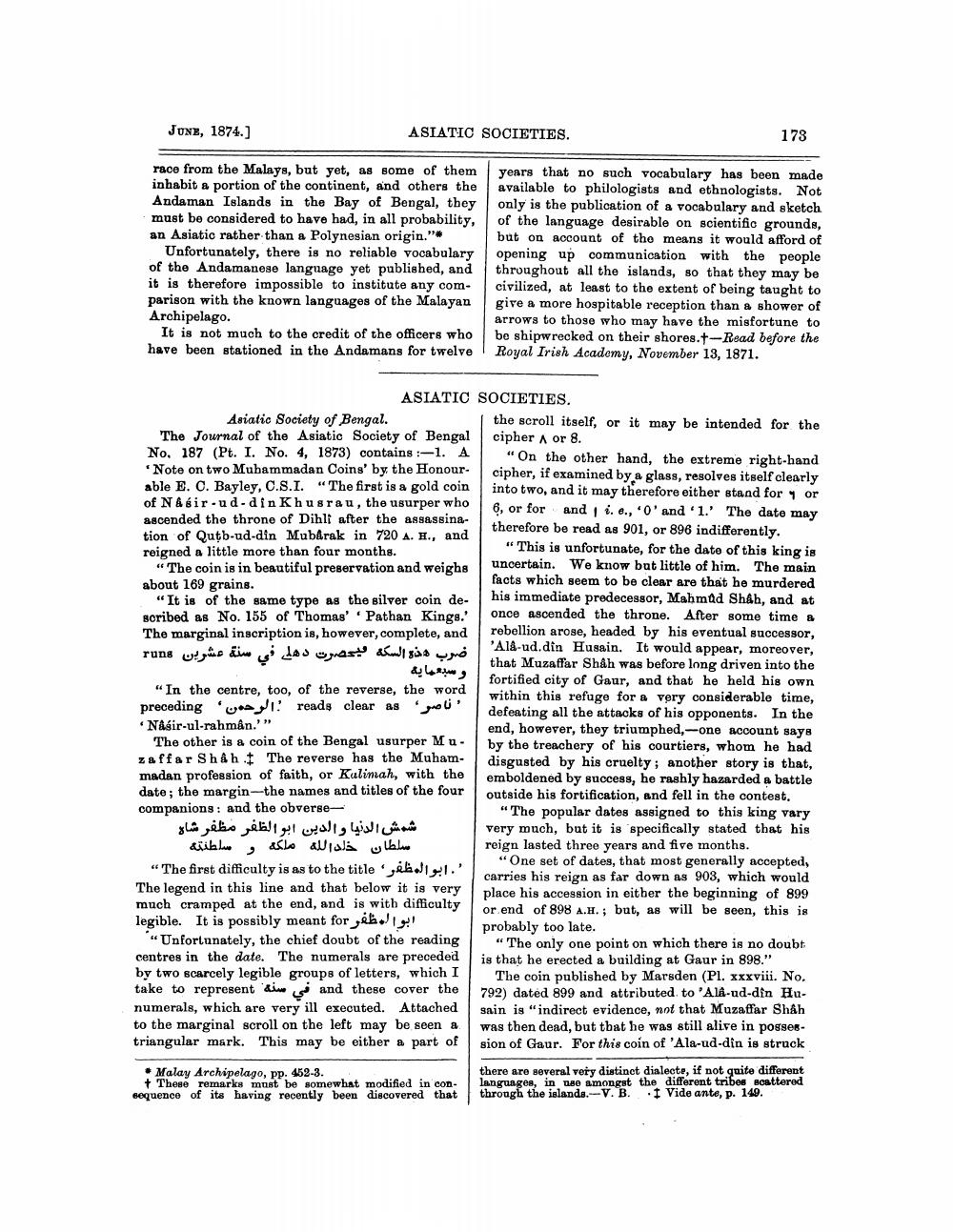________________
JUNE, 1874.]
race from the Malays, but yet, as some of them inhabit a portion of the continent, and others the Andaman Islands in the Bay of Bengal, they must be considered to have had, in all probability, an Asiatic rather than a Polynesian origin."*
Unfortunately, there is no reliable vocabulary of the Andamanese language yet published, and it is therefore impossible to institute any comparison with the known languages of the Malayan Archipelago.
It is not much to the credit of the officers who have been stationed in the Andamans for twelve
ASIATIC SOCIETIES.
Asiatic Society of Bengal.
The Journal of the Asiatic Society of Bengal No. 187 (Pt. I. No. 4, 1873) contains:-1. A 'Note on two Muhammadan Coins' by the Honourable E. C. Bayley, C.S.I. "The first is a gold coin of Nasir-ud-din Khusrau, the usurper who ascended the throne of Dihli after the assassination of Qutb-ud-din Mubarak in 720 A. H., and reigned a little more than four months.
"The coin is in beautiful preservation and weighs about 169 grains.
"It is of the same type as the silver coin described as No. 155 of Thomas' Pathan Kings.' The marginal inscription is, however, complete, and
ASIATIC SOCIETIES.
ضرب هذه السكه فيحصرت دهل في سنة عشرين runs
و سبعمايه
"In the centre, too, of the reverse, the word preceding reads clear as '
Nasir-ul-rahmân.'"
The other is a coin of the Bengal usurper Muzaffar Shah The reverse has the Muhammadan profession of faith, or Kalimah, with the date; the margin-the names and titles of the four companions: and the obverse
و
شمش الدنيا والدين ابو الظفر مظفر شاه سلطنته سلطان خلد الله ملكه
"The first difficulty is as to the title.'
The legend in this line and that below it is very much cramped at the end, and is with difficulty legible. It is possibly meant for ho!!!!
"Unfortunately, the chief doubt of the reading centres in the date. The numerals are preceded by two scarcely legible groups of letters, which I take to represent and these cover the numerals, which are very ill executed. Attached to the marginal scroll on the left may be seen a triangular mark. This may be either a part of
Malay Archipelago, pp. 452-3.
These remarks must be somewhat modified in consequence of its having recently been discovered that
173
years that no such vocabulary has been made available to philologists and ethnologists. Not only is the publication of a vocabulary and sketch of the language desirable on scientific grounds, but on account of the means it would afford of opening up communication with the people throughout all the islands, so that they may be civilized, at least to the extent of being taught to give a more hospitable reception than a shower of arrows to those who may have the misfortune to be shipwrecked on their shores.+-Read before the Royal Irish Academy, November 13, 1871.
the scroll itself, or it may be intended for the cipher A or 8.
"On the other hand, the extreme right-hand cipher, if examined by a glass, resolves itself clearly into two, and it may therefore either stand for or 6, or for and i. e., '0' and '1.' The date may therefore be read as 901, or 896 indifferently.
"This is unfortunate, for the date of this king is uncertain. We know but little of him. The main facts which seem to be clear are that he murdered his immediate predecessor, Mahmûd Shah, and at once ascended the throne. After some time a rebellion arose, headed by his eventual successor, 'Ala-ud.din Husain. It would appear, moreover, that Muzaffar Shâh was before long driven into the fortified city of Gaur, and that he held his own within this refuge for a very considerable time, defeating all the attacks of his opponents. In the end, however, they triumphed,-one account says by the treachery of his courtiers, whom he had disgusted by his cruelty; another story is that, emboldened by success, he rashly hazarded a battle outside his fortification, and fell in the contest.
"The popular dates assigned to this king vary very much, but it is specifically stated that his reign lasted three years and five months.
carries his reign as far down as 903, which would "One set of dates, that most generally accepted,
place his accession in either the beginning of 899 or end of 898 A.H.; but, as will be seen, this is probably too late.
"The only one point on which there is no doubt is that he erected a building at Gaur in 898."
The coin published by Marsden (Pl. xxxviii. No. 792) dated 899 and attributed to 'Alâ-ud-din Husain is "indirect evidence, not that Muzaffar Shah was then dead, but that he was still alive in possession of Gaur. For this coin of 'Ala-ud-din is struck
there are several very distinct dialecte, if not quite different languages, in use amongst the different tribes scattered through the islands.-V. B. . Vide ante, p. 149.




